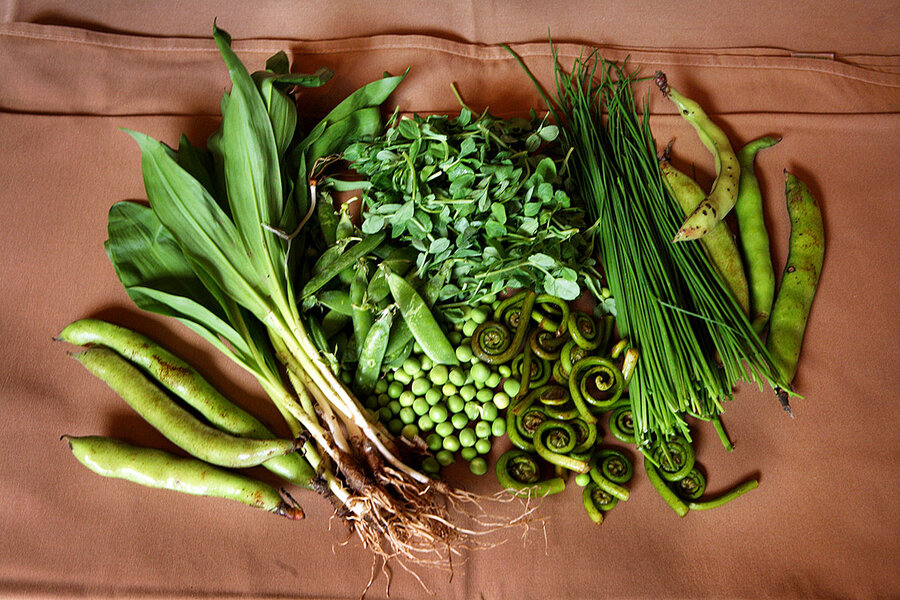Burger shaming is out: Coaxing carnivores to climate-conscious eating
Loading...
Sometimes, slow roasted and caramelized veggies can beat out the hamburger. Especially when a side of climate action is added to the menu.
This, at least, is what researchers at the World Resources Institute found in a newly released study that explores how different messages about global warming affect what people order for lunch and dinner.
Researchers were particularly interested in what – and whether – wording on a menu might nudge eaters toward plant-based options, which have a lower carbon footprint than animal proteins. What they found is that not only do climate messages work to encourage plant-based picks, but some phrases made diners almost twice as likely to go for the veggies.
Why We Wrote This
What’s more likely to change someone’s behavior? A carrot or stick? A study about meal choices in restaurants recommends welcoming carnivores into the plant-based fold.
This result adds to a growing body of research not only about the impact of our food choices, but about how to inspire climate-friendly behavior changes. And once again, researchers say, tapping into people’s desire to do good seems to be the most effective way to spark action.
“What we found was that it’s persuasive to see a climate-friendly message when you’re choosing what to eat from a menu,” says Edwina Hughes, head of the Cool Food Pledge at the World Resources Institute. But the language had to be inclusive, she says, with no burger shaming allowed.
“It’s about people choosing and feeling involved and activated,” she says. “We’ve seen that language and terminology and framing that alienates meat eaters can be really unhelpful.”
A “big tent” that includes carnivores
The findings connect to a growing body of research that is, in many ways, shifting the way activists and scholars talk about climate change. Out are the arguments about whether climate change exists, or about just how brutalized the world will find itself from sea level rise, increased heat waves, and newly powerful storms. (Finger wagging about your neighbor’s SUV or gas stove is also generally unhelpful, experts say.)
What’s far more effective, say a growing collection of scholars and activists, are climate conversations grounded in empowerment, hope, and belonging.
“How we talk about the options available to people can have a big impact on how willing they are to take advantage of those options,” says Ed Maibach, who directs the George Mason University Center for Climate Change Communication. “In short, words matter, a lot.”
In this new World Resources Institute study, the most effective climate message was a statement telling diners they could have a big impact by taking a small action; in particular, that “swapping just one meat dish for a plant-based one saves greenhouse gas emissions that are equivalent to the energy used to charge your phone for two years.” Another successful message was this: “90% of Americans are making the change to eat less meat. Join this growing movement and choose plant-based dishes that have less impact on the climate and are kinder to the planet.”
Dr. Maibach says he calls the type of messaging in the World Resources Institute menu study “elephant food – because it’s attractive to our emotions and our sense of self, and therefore draws us in.”
Other words, he said, can be “elephant repellants.” Researchers have found that classifying items as “vegetarian” or “vegan” tends to push diners toward meat, for instance. Other studies have found that descriptions such as “slow-cooked,” “simmered,” and “caramelized” make plants sound tastier – as does the category “field grown,” as opposed to “meat-free.”
Ms. Hughes describes this as making a “big tent” for climate action, allowing people from different backgrounds and perspectives – carnivores included – to feel part of something important.
“It has to come from their own hearts”
That’s part of the potential of climate-related food choices, says Toby Park, principal adviser and head of energy, environment, and sustainability work at the United Kingdom-based Behavioural Insights Team policy group and author of “A Menu for Change,” a detailed 2020 report about why and how people make choices about food.
There are complicated cultural and identity markers involved with what we eat – just look at the panicked reaction to false rumors that President Joe Biden would restrict Americans’ access to hamburgers. But people are also able to make simple changes.
“Being an environmentally conscious citizen can be exhausting,” Mr. Park says. “We need to worry about the plastic we’re using, how much energy we use at home, what car we drive (or how to give up our car entirely), flying less (oh, and do carbon offsets even work?), and now what we eat, too. But if you were to focus on just one thing, food would be a very good candidate.”
That’s because food consumption counts for about a quarter of greenhouse gas emissions in most developed countries, according to the United Nations Food and Agriculture Organization. One recent study published in the journal Nature Food found that the entire food production system, including farm machinery and food transport and other variables, accounted for some 35% of the world’s emissions – with most coming from meat production.
Atul Jain, a climate scientist at the University of Illinois Urbana-Champaign who co-wrote that study, says his researchers found that meat production was responsible for 57% of agricultural emissions, compared with 29% from plant-based foods. (The remaining 14% is from agricultural products we don’t eat, such as cotton and tobacco.)
Still, Dr. Jain isn’t insisting people change their diets. He says he knows better than to do that.
“It has to come from their own hearts,” he says. “I believe in education – educating the younger generation who are concerned about climate change about what their contributions are in terms of their carbon footprints.”







